Charge
Answering President Abraham Lincoln's call for troops to defend the Union following the fall of Fort Sumter in Charleston Harbor, the day after the battle Minnesota Governor Alexander Ramsey creates the First Minnesota Volunteer Infantry Regiment from 1,009 men of the city of St. Paul and other nearby towns (lots of loggers and farmers, one man, Newton Brown, will walk 65-miles barefoot to enlist). The unit is mustered into existence (for three years of service) at Fort Snelling, Minnesota on April 29, 1861 and by the Fourth of July they are stationed in Alexandria, Virginia, completing their training under the command of Colonel Willis A. Gorman. The unit sees action for the first time at the First Battle of Bull Run (7/21/1861) ... in the thick of the afternoon fighting that takes on Henry House Hill supporting the artillery guns of Captain James B. Ricketts, the unit has a casualty loss of 20%, with 49 killed, 107 wounded, and 31 missing. At the Battle of Antietam (9/17/1862), still the bloodiest day in American history, the unit fares even worse during Major General John Sedgwick's ill-fated morning assault on Confederate forces positioned within the battlefield's infamous West Woods ... contributing Minnesota crimson to the carnage with a 28% casualty rate consisting of 16 killed, 82 wounded, and 24 missing (122 casualties out of 435 soldiers engaged). Nowhere as desperate and deadly as at First Bull Run or Antietam, the men from Minnesota are also present for the Battle of South Mountain (9/14/1862), Major General George McClellan defeat at the Battle of Ball's Bluff (10/21/1861), McClellan's bungled Peninsula Campaign of 1862 (March to July), the Seven Days Battles outside of Richmond, Virginia (6/25/1862 to 7/1/1862), the disastrous Battle of Fredericksburg (12/11/1862 to 12/15/1862), and Major General Joseph Hooker's defeat at the Battle of Chancellorsville (4/30/1863 to 5/6/1863). It is at Gettysburg however that the First Minnesota has its finest day.
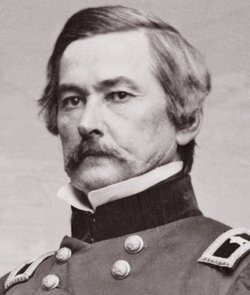
Gorman
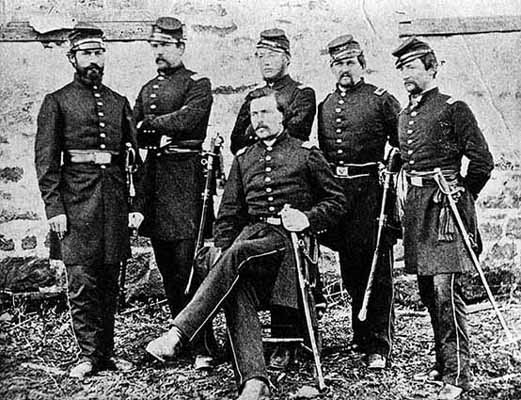
First Minnesota Officers - Left To Right Back Row - Captain Wilson Farrell, Lt. Samuel
Raguet, Captain Louis Muller, Lt. Charles Zurenberg, And Captain Henry Coates -
Center - Major Mark Downie
Part of the 12,000 men in the II Corps of the Union Army (their new commander as of 5/22/1863 is Major General Winfield Scott Hancock who will become known as "Hancock the Superb" for his actions during the battle), the 262 men of the whittled down First Minnesota (three companies are on detached duty, Colonel William Colvill Jr. is in command of the rest of the unit) arrive on the Gettysburg battlefield shortly after sunrise on the second day of the clash (it is Thursday and the weary men have averaged a daily fourteen mile march for two weeks) and are assigned a place on the Union's line to protect and support Battery C of the 4th U.S. Artillery. Disaster impending when the line is compromised by "political" soldier Major General Daniel Sickles moving his III Corps forward without orders (the man is also the murderer of Philip Barton Key II for the man having an affair with Sickle's wife), Hancock spends the day trying to stave off disaster as he moves units about the field to help at crisis areas ... by late afternoon though, he has a last crisis to deal with and is almost out of troops to commit, there is a gap in the Union line that is about to be attacked by Confederate troops..
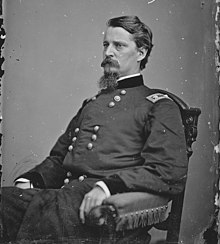
Hancock

Colvill
Another snap decision (if the gap is exploited, Confederate troops will split the Union Army in half and can roll up the segmented flanks of the northerners), Hancock orders the divisions of Brigadier General John Gibbon and Brigadier General Alexander Hays into the opening, but the movement of men will take five minutes of time, time Hancock doesn't have unless he can find a means of stopping the immediate southern advance. He finds his means in the men of the First Minnesota. Seeing a regiment of blue soldiers moving towards him, Hancock gallops up to the officer commanding the column and asks, "What regiment is this?" The answer comes back immediately, "First Minnesota, Sir!" (a regiment that belongs to Hancock's II Corps, and that is commanded by a man only three days before, Hancock had placed under arrest for allowing his men to slow their advance by staying dry and crossing a river single file over a log instead of everyone wading the three-foot-deep wet, 33-year-old Colonel William J. Colvill Jr.). "Colonel, do you see those colors?" Hancock calls out, pointing to Alabama flags approaching, with Colvill stating his acknowledgment of the colors, the general then gives his orders, "Advance, Colonel, and take those colors." One regiment against a brigade, murder (Irish-born lawyer Lt. William Lochran will later write, "Every man realized in an instant what that order meant - death or wounds for us all; the sacrifice of the regiment to gain a few minutes of time, and probably the battlefield ... but unwilling to face Hancock's wrath again, Colvill orders his men forward on double-quick.
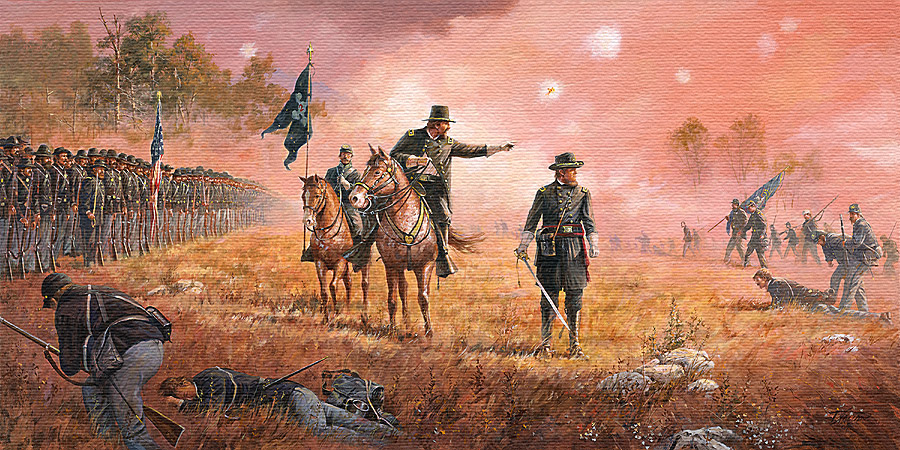
"Take Those Colors!"
Born in Forestville, New York on April 5, 1830, Colvill is the son of Irish-Scottish parents. Intellectually gifted (he graduates from Fredonia Academy and teaches at a country school for a year before studying law), he reads law out of the offices of 13th U.S. President, Millard Fillmore and in 1851 passes the bar. For three years he practices law in New York before migrating to Minnesota, where along with opening up a law office, Colvill becomes active with Minnesota's Territorial Council and establishes the Red Wing Sentinel in the town of Red Wing. When the Civil War breaks out with the shelling of Fort Sumter, Colvill becomes the first man to volunteer from Goodhue County and is elected captain of Company F of the First Minnesota Volunteer Infantry. Wounded in the shoulder at the 1862 Battle of White Oak Swamp (he is an easy target, measuring 6'5" in his stocking feet), by the time of Gettysburg Colvill is a colonel in command of what is left of the First Minnesota.
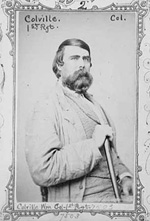
Colvill
Opposing Colvill is the brigade of 39-year-old Brigadier General Cadmus Marcellus Wilcox. Born on May 20, 1824 in Wayne County, North Carolina, Wilcox is raised and educated in Tennessee (his family moves there when he is only two), attending Cumberland College before matriculating at West Point with its class of 1846 (among his classmates are future generals, George B. McClellan and Thomas J. "Stonewall" Jackson, he finishes #54 out of a class of 59). During the Mexican-American War, Wilcox gallantly fights at the Battle of Veracruz, the Battle of Cerro Gordo, the Battle of Chapultepec, and the Battle of Mexico City. After the war, he remains in the army, teaches at West Point, spends a year in Europe, and writes a manual on rifles and rifle firing. He is a captain in the New Mexico Territory when the Civil War begins and he joins the Confederacy. On the other side of many of the battles Colvill is also in, by the time of Lee's Gettysburg Campaign, Wilcox is a brigade commander reporting to Major General R. H. Anderson, belonging to the III Corps of Lt. General A. (Ambrose) P. (Powell) Hill (for the day, he is on loan to Lt. General James Longstreet for use in the attack Lee has ordered his I Corps to make against the left of the Union line atop Cemetery Ridge).
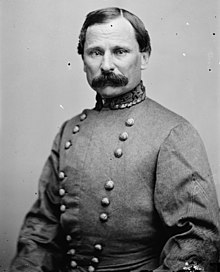
Wilcox
Off without hesitation, Colvill's men charge down the rise, level their bayonets, shout "HURRAH," and then crash into Wilcox's brigade . Already tired from a run of over a mile and the fight they have made reaching the Union line, surprised at being attacked themselves, the Alabamians recoil as the First Minnesota hits them just as they are crossing a small creek (the infamous Plum Run which will turn crimson during the battle), but after a few moments, come on again and pour devastating fire on to Colvill's command. In the blood bath that takes place, five times the Minnesota flag goes down, and five times it rises, Colvill is hit three times and severely wounded (hit in the right shoulder and ankle, a bullet will clip off a piece of vertebra in the colonel's back and he argues doctors out of amputating his damaged foot ... making a slow recovery first in a Private Gettysburg home, then at a Harrisburg, Pennsylvania hospital, Colvill is not out of bed until February of 1864 and walks with a cane for the rest of his life ... mustered out of the army as a brigadier general in 1865, he spends the next forty years in Minnesota as a member of its legislature, as the state's attorney general, practicing law, as register of the Duluth Land Office, and running his farm, which will one day be the small community of Colvill. He dies in his sleep at the age of 75 while attending a reunion of First Minnesota veterans in 1905. At the dedication of the statue that stands at his grave, President Calvin Coolidge will state, "Colonel Colvill and those eight companies of the First Minnesota are entitled to rank as saviors of their country."), and all but three officers are hit. Needing five minutes for supports to arrive, the men of the First Minnesota Volunteer Infantry instead give Hancock (he will later praise the men for their unsurpassed gallantry and heroism, the highest known in the annals of warfare) fifteen minutes (seeing Union troops approaching his flanks, with no supports behind him, Wilcox will retreat back down the hill). But the time comes at the grisly cost of 215 casualties (retreating with discipline and their faces forward, Captain Nathan Messick will lead the 47 unscathed survivors of the clash back to the Union line), an 82% rate, still the largest percentage of casualties to be taken by any U.S. regiment in a single day of battle!
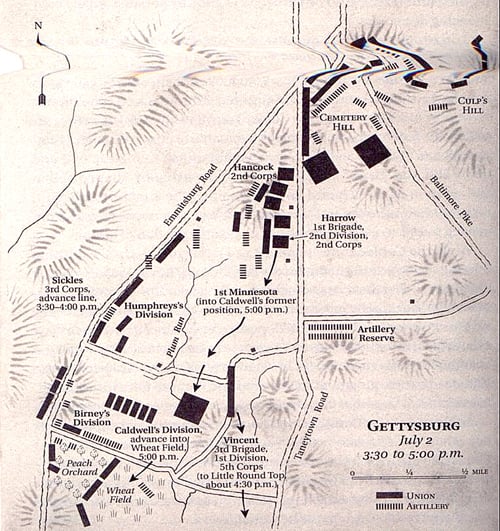
Map Of The Charge
First Minnesota
Charge

Last Full Measure
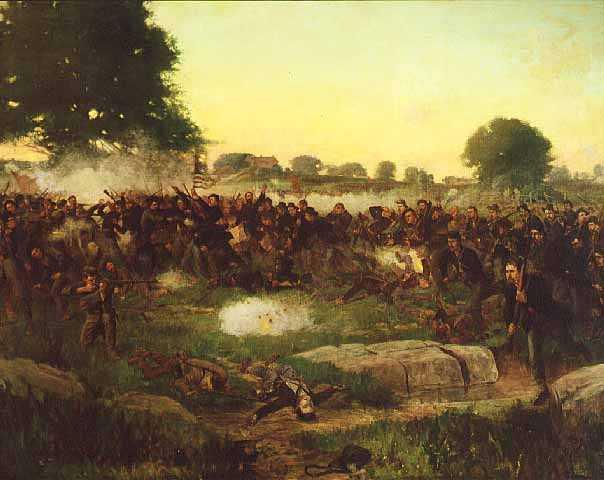
Attack (Colvill Is Slightly To Right Of Flag, Arm Upraised)

Retiring With Order
Union line saved for a third day of mayhem, the survivors of the charge are reinforced by one of its detached companies returning to the unit (Company F) and moved slightly north on Cemetery Ridge to rest and recuperate ... right at one of the spots in the line Picketts Charge of 7/3/1863 will try to breach. Again at the seemingly epicenter of the battle's carnage, the men of the First Minnesota will charge an advancing enemy of superior numbers ... and once again southern attackers can not get past the men of the Land of 10,000 Lakes. But again, there is a cost to pay ... attacking the attackers (the First Minnesota will lose seventeen more men on the third day of Gettysburg), slightly wounded twice the day before, 36-year-old Captain Messick is killed by a shell fragment that just above his right eye, and then his replacement, 33-year-old Captain Farrell, is mortally wounded and goes down too (at the end of the day, Captain Henry C. Coates will be in command).
Pickett's Charge
Messick
Coates
And once again there is glory for the men of Minnesota. Picking up the unit's flag when the last color bearer falls, 21-year-old St. Anthony Falls miller, Corporal Henry O'Brien wins a Congressional Medal of Honor for leading the charge to the right, carrying the flag throughout the rest of the battle despite taking a grazing round to the head and a second bullet that punches through the soldier's hand (it will cut the flagstaff in half after blowing out of the back of O'Brien's palm). And 41-year-old Private Marshall Sherman of St. Paul (where he is a house painter) also receives a Congressional Medal of Honor for capturing, at the point of his bayonet, the battle flag of 28th Virginia Regiment of Brigadier General Richard Garnett (who is yet another casualty of the battle).

O'Brien

Sherman And Flag
Heroes over a century ago, the men of the First Minnesota Volunteer Infantry remain heroes to this day! On the Gettysburg battlefield there are three memorials to the northerners ... one is a statue of a soldier running forward that stands at the spot where Colvill's charge began, another is an obelisk marking where Minnesota met the Virginians of Garnett during Pickett's Charge, and there is a memorial urn in the national cemetery on the battlefield that honors the First Minnesota. And back in Minnesota itself, the souvenirs and trophies of the Civil War include the battle flag Private Sherman captured (with the Minnesota Historical Society despite Virginia's repeated attempts to get it back), the First Minnesota badge Sgt. Chesley Tirrell wears into battle, an officer's hat insignia, and the Minnesota men's battle flag ... along with having a statue in the Minnesota State Capital honoring his deeds, Colonel Colvill has a park named after him in the town of Red Wing, and there is a section of State Highway 19 between the towns of Gaylord and Red Wing named for the First Minnesota's gallant commander.
Where The Charge Took Place
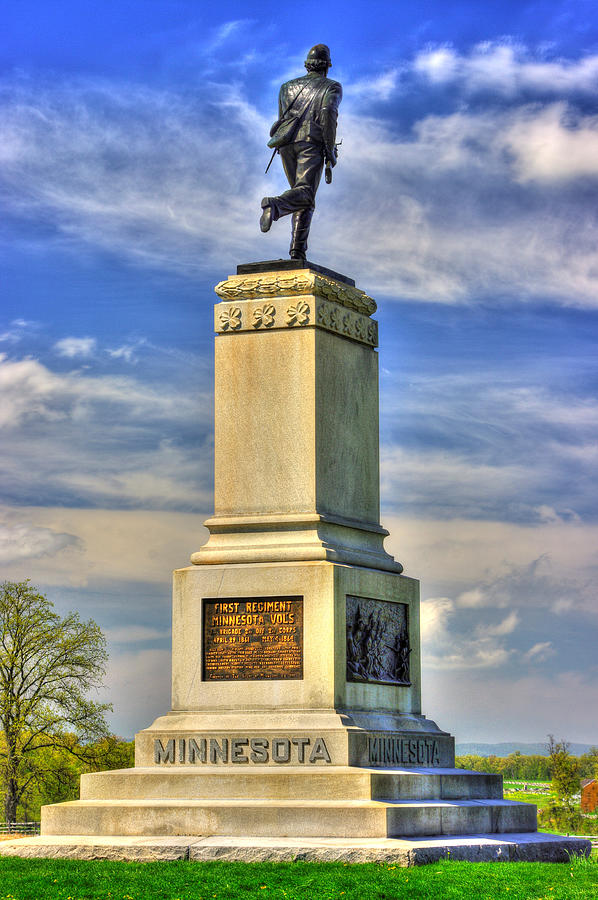
Charge Monument

Where The Men Met
Pickett's Charge
Bronze Bas-Relief On Obelisk

Memorial Urn At Gettysburg National Cemetery
Captured Battle Flag
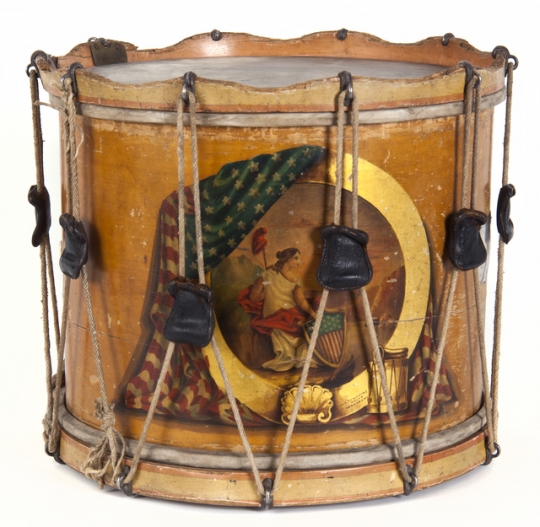
Snare Drum Of The First Minnesota

Battle Flag Of The First Minnesota

First Minnesota Badge Worn By
Sergeant Chesley Billings Tirrell

Colvill
7/2/1863 ... the largest and bloodiest battle to take place on North American soil enters its second day, a second day in which a few men from Minnesota help decide the fate of their nation ... may their sacrifices never be forgotten.
Charge Painting Detail - Colvill To Right Of
Flag With Arm Raised
1905 Reunion Parade
Reunion Medal With Colvill Badge
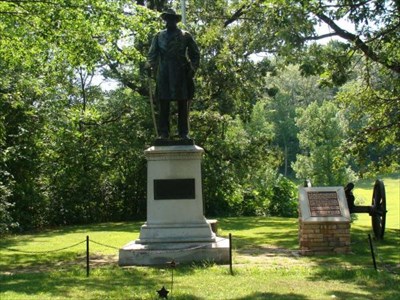
Colvill Grave & Statue
Outstanding what brave men.
ReplyDelete